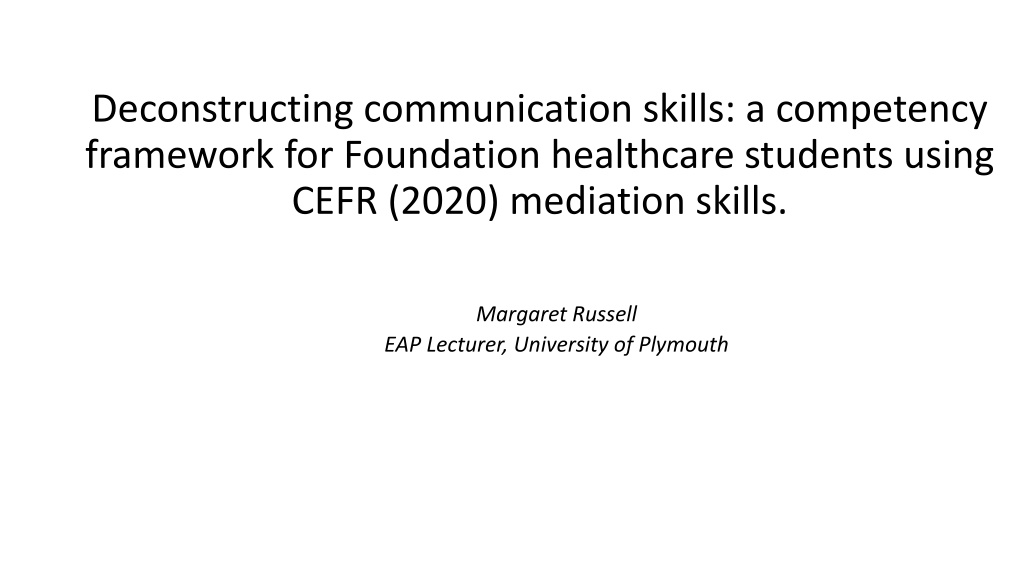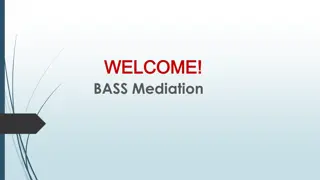Enhancing Communication Skills in Healthcare Education Through Mediation Framework
Utilizing the CEFR Mediation skills framework, this study explores the benefits of incorporating mediation skills in healthcare communication for Foundation stage university students. The integration of mediation descriptors helps create a competency framework that focuses on adaptability, intercultural awareness, and soft skills crucial for effective collaborative communication. By addressing the communicative needs of diverse healthcare students, this approach enhances their ability to convey information in a pluricultural context through patient-clinician roleplay tasks.
Download Presentation

Please find below an Image/Link to download the presentation.
The content on the website is provided AS IS for your information and personal use only. It may not be sold, licensed, or shared on other websites without obtaining consent from the author. Download presentation by click this link. If you encounter any issues during the download, it is possible that the publisher has removed the file from their server.
E N D
Presentation Transcript
Deconstructing communication skills: a competency framework for Foundation healthcare students using CEFR (2020) mediation skills. Margaret Russell EAP Lecturer, University of Plymouth
Outline Why use CEFR (2020) Mediation skills Context/Process CEFR (2020) Mediation skills Creation of Mediation competency framework Framework in use: self and peer assessment Using mediation descriptors for various tasks Usefulness of CEFR Mediation
Why use CEFR (2020) Mediation skills for deconstructing communication? Mediation skills are special/useful for effective communication because In mediation one is less concerned with one s own needs, ideas or expression than with those of the party or parties for whom one is mediating as a social agent (Piccardo, North and Goodier, 2019) ie when conveying information. Hence, there is a heightened awareness of the other person in the interaction. So mediation includes skills such as adapting language, intercultural awareness and the use of soft skills such as respect, sensitivity. And the CEFR (2020) Companion Volume has created Mediation descriptors for these vital (more holistic) skills of successful collaborative communication. Mediation resonates with an action-oriented approach which emphasizes purposeful, collaborative tasks (Beacco et al, 2016) Mediation combines language proficiency with transferable skills associated with professional knowledge and future employability (Pavlovskaya and Lankina, 2019)
Context/Process Foundation stage university healthcare students ESAP C1 communication needs identified Patient:clinician roleplay communicative task CEFR (2020) Mediation descriptors/skills chosen and adapted to create a mediation competency framework to meet communicative needs and task Mediation competency framework used as a learning tool to formatively practise/assess communicative performance in roleplay task
Context and students communication needs 17 international university Foundation Stage healthcare students (target level C1), 12 nationalities, 8 healthcare professions Basic need: ability to understand and convey information appropriately in a pluricultural context (academically and professionally)
Patient:clinicianroleplay task Action-oriented activity Relevant content: learner-generated research/sense of ownership, subject- specific patient case study (this was researched by the students) Range of skills which could meet students communicative needs (ie using appropriate language, encouraging discussion, intercultural awareness/sensitivity)
Create mediation competency framework communication needs Common European Framework of Reference: CEFR (2020) Mediation skills tend to reflect Vygotsky s (1978) social constructivism theory sociocultural competence (Hymes, 1972; Canale and Swain, 1980) interactional competence (Kramsch, 1986; Hall, 1995) functional competence can do (Savignon, 2002)
All modes of communication are activated in CEFR Mediation, where a source text/information is (re)formulated for another person (cognitive mediation)(academically ie presentation, professionally ie roleplay) to facilitate understanding and communication through mediation languaging (relational mediation) (Piccardo, 2020; Coste and Cavalli, 2015). The relationship between reception, production, interaction and mediation (CEFR, 2020:34)
CEFR Mediation skills (2020): a unique and useful interplay of micro skills to be integrated as in real-life communication
Mediation profiling: look up and down CEFR descriptors to find a profile, use descriptors vertically as well as horizontally (ie B2 mentions useful skills/ideas even for C1 learners = range of competences) Overall Mediation descriptors for C1 and B2 (CEFR,2020)
Mediation skills What you think (good, ok, find tricky/improve) How you did (good, ok, find tricky/improve) Processing text in speech Can clearly and confidently sequence, summarise, signpost information Can adjust use of language to ensure meaning is clear Can be understood clearly with appropriate use of pace/pauses, word and sentence stress, and tone of voice Explaining a new concept Can explain/check understanding of key points/complex details clearly and link to previous knowledge Collaborative interaction Can ask appropriate questions for clarification/demonstrate interest (also small talk/personalisation) Can elicit/encourage patient s ideas/concerns and use active listening, and appropriate turntaking, to allow patient to speak Can weigh up different points of view/possibilities using logical reasoning (hypothesising, analysing, inferring, justifying, predicting) + how agreement might be achieved Facilitating communication Can maintain positive/respectful interaction and anticipate problems in intercultural encounters Can demonstrate sensitivity and empathy to patient s perspectives Can establish a positive/supportive environment, also with use of appropriate body language A descriptor you would like to add Making decisions for future ie treatment plan, family support
Framework in use 4 sections (Processing text in speech, Explaining a new concept, Collaborative interaction, Facilitating communication) to aid ease of use/reuse and recall The 10 competencies can be used flexibly/sense of ownership ie active listening and sensitivity can be used throughout the task New CEFR 2020 supporting scales also used ie for phonological control (intelligibility - Walker et al, 2021). Reference was also made to NHS values (ie respect, empathy), and Occupational English Test for healthcare (2018) - many similar skills to CEFR mediation skills.
Self (pre and post)and peer assessment using competency framework (Criterion-referenced: Good, OK, Improve) Self assessment Learners post-task felt they were better at soft skills included in Facilitating communication (inherent in healthcare students?) .but poorer at Collaborative interaction skills such as turntaking, and adjusting use of language (ie awareness of others understanding in the interaction) Peer assessment A peer rating index (PRI) determined a 60% agreement between students and teacheron individual s performance of each mediation skill. Thisillustrated an ability to mostly recognise the use of the mediation skills. Soft skills, adapting use of language and intelligibility received lower average PRI skills hard to recognise/judge?
Example of student language in roleplay (some useful language can be fed in for learners with lower levels of language) It s completely understandable to be worried. Whenever you re ready, can you please mention when this problem started to be seen and what were the first steps that you undertook. Shows empathy, sensitivity, gives patient opportunity to speak Good active listening nods, yes, ok Yes, I clearly understand. My question is if you might know what type of strabismo your child has as there are many types of it. Checks patient previous knowledge Thank you for informing me about the disease history and I also want to ensure that your son gets the best possible treatment so it was a good idea to make another consultation. Confident It is true what you say, there are many other treatment options, so surgery from my professional knowledge and skill should be the last alternative suggested for a 4 year old child. Confidence and Weighs up different possibilities
Using mediation descriptors for other tasks Presentations Processing text in speech Good OK Improve Can clearly and confidently summarise, signpost information Can clearly interpret and explain data/details Can weigh up different points of view/possibilities using logical reasoning (hypothesising, analysing, justifying, predicting) Can be understood clearly with appropriate use of pace/pauses, word and sentence stress, and tone of voice Can answer questions clearly, sensitively and confidently
Academic discussion task What you think (good, ok, find difficult) How you did (good, ok, improved) Adapted Mediation descriptors from CEFR (2018) Processing text in speech Can identify and summarise clearly key points Can interpret and describe clearly visual data Collaborative interaction with peers Can weigh up different points of view + how agreement might be achieved Can follow a line of argument Can ask questions for clarification/demonstrate interest Can ask questions to stimulate logical reasoning (hypothesising, analysing, inferring, justifying, predicting) Can make sure everyone is included, no one dominates, a collaborative/positive environment Facilitate pluricultural communication Can act as mediator in intercultural encounters, anticipate problems, maintain positive interaction Can demonstrate sensitivity to different perspectives, formulate any reservations/disagreements in such a way as to avoid offence Expressing a personal response Can express clearly reactions and emotions to a text + say why
Tasks Mediation skills Learners discuss which grammatical options could be correct, and why Encouraging conceptual talk Learners discuss what they might already know about a topic Linking to previous knowledge Learners sensitively discuss ie dress code or medical choices related to cultures Facilitating communication in delicate situations and disagreements One learner explains information from a subject- specific text to another learner in language which other can understand Adapting language Breaking down complicated information Learners explain to each other how New Year is celebrated in their country Relaying specific information Group discussion task where learners have to decide upon one option Facilitating collaborative interaction with peers
Usefulness of CEFR Mediation Language for describing behaviours and labelling, ongoing reference and feedback tool, Can do is positive, goal-setting. Shared/cooperative learning, co-constructing meaning: Transfer/exchange of information is on various levels as in real-life, integrated skills and action-orientedview of language (ie skills in framework come to my mind when I conduct a 1:1 tutorial; can help managers ensure relationships in teams and with individuals are inclusive, positive, supportive and collaborative). Transferability of skills academically and professionally, useful for 1st language speakers as not just linguistic skills. Use of soft skills respect, empathy, sensitivity, Adapting language use (register, speed etc), Critical thinking skills logical/analytical reasoning, weighing up possibilities (Bloom s taxonomy) Heightens awareness of others needs and cultures in communication helps make communication successful and charming
References Beacco. J, Byram, M., Cavalli, >, Coste, D. Cuenat, M., Goullier, F. and Panthie, J. (2016) Guide for the development and implementation of curricula for plurilingual and intercultural education. Strasbourg: Council of Europe. Available at: https://www.coe.int/en/web/language-policy/guide-for-the-development-and-implementation-of-curricula-for-plurilingual-and-intercultural-education Canale, M. and Swain, M. (1980) Theoretical bases of communicative approaches to second language teaching and testing , Applied Linguistics, 1(1), pp. 1-47. Available at: https://academic.oup.com/applij/article/I/1/1/181953?login=true Common European Framework Companion Volume (2020) Council of Europe. Available at: https://rm.coe.int/common-european-framework-of-reference-for-languages-learning-teaching/16809ea0d4 Coste D. and Cavalli M. (2015) Education, Mobility, Otherness the mediation functions of schools, Language Policy Unit, Council of Europe, Strasbourg. Available at https://rm.coe.int/16807367ee Goodier, T. (2019) Focus paper: Mediation in English Language Teaching. Oxford:OUP. Available at: https://www.oup.es/en/EF-mediation-programme Hall, J. (1995) (Re)creating our worlds with words: A sociohistorical perspective of face-to-face interaction . Applied Linguistics, 16(2), pp.206 232. Available at: https://pennstate.pure.elsevier.com/en/publications/recreating-our-worlds-with-words-a-sociohistorical-perspective-of Hymes, D.H. (1972) On Communicative Competence in Pride, J.B. and Holmes, J. (eds) Sociolinguistics. Selected Readings. Harmondsworth: Penguin, pp. 269-293 Kiddle, T. (2019) The CEFR Companion Volume Mediation Scales operationalised: Towards English for Professional Purposes in action , EAQUALS, Krakow. Available at: https://www.eaquals.org/wp- content/uploads/The-CEFR-Companion-Volume-Mediation-scales-operationalised.pdf Kramsch, C. (1986) From Language Proficiency to Interactional Competence , The Modern Language Journal, 70(4), pp. 366-372. Available at: https://www.jstor.org/stable/326815 Kurtz, M., Silverman, J. and Draper, J. (2005) Teaching and Learning Communication Skills in Medicine. 2nd edn. Oxford: Radcliffe Publishing North B. and Piccardo E. (2016), Developing illustrative descriptors of aspects of mediation for the CEFR , Education Policy Division, Council of Europe, Strasbourg. Available at: https://rm.coe.int/168073ff31 Occupational English Test OET (2018) Available at: https://www.occupationalenglishtest.org/oet-uk/ Pavlovskaya, I. and Lankina, O.(2019) How new CEFR mediation descriptors can help to assess the discussion skills of management students - Global and analytical scales , CEFR Journal Research and Practice, pp.33-44 Piccardo, E. (2020) Plurilingual and pluricultural competence in the new CEFR: the mediated nature of language learning and use . ALTE 2020 Toronto. Available at: https://www.alte.org/resources/Documents/Piccardo_ALTE_plenary_FINAL.pdf Piccardo, E., North, B. and Goodier, T. (2019) Broadening the scope of language education: plurilingualism, mediation and collaborative learning: the CEFR Companion Volume, Journal of e-Learning and Knowledge Society, 15(1), pp.17-36. Available at: https://www.academia.edu/41323540/Piccardo_E_and_North_B_2019_Broadening_the_scope_of_language_education_plurilingualism_mediation_and_collaborative_learning Savignon, S. J. (2002) Interpreting communicative language teaching: Contexts and concerns in teacher education. New Haven: Yale University Press. Walker, R., Low, E., and Setter, J. (2021) Position paper: English pronunciation for a global world. Oxford: Oxford University Press. Available at: Expert advice on | Oxford University Press (oup.com) Vygotsky, L. S. (1978) Mind in Society. Cambridge, MA: Harvard University Press























